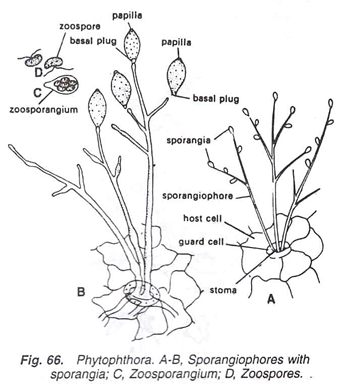ADVERTISEMENTS:
In this article we will discuss about the asexual and sexual reproductive structure of phytophthora.
Asexual Reproduction of Phytophthora:
1. Asexual reproduction takes place by conidiosporangia developed on branched conidiophores or sporangiophores.
2. Sporangiophores are the branched hyphae which come out through the stomata of the host leaf.
ADVERTISEMENTS:
3. At the tip of the branches of sporangiophores develop sporangia (Fig. 66).
4. Each sporangium is an oval, multinucleate structure with a short stalk.
5. A thin, hyaline papilla is present at the tip of each sporangium.
6. At first, sporangia are terminal but later on they become lateral due to the sympodial branching in sporangiophores.
ADVERTISEMENTS:
7. Multinucleate protoplasm of sporangium divides into many uninucleate structures, which later on form bi- flagellate, kidney-shaped zoospores (Fig. 66C, D). These form the new mycelium on germination.
Sexual Reproduction of Phytophthora:
1. Sexual reproduction is oogamous and takes place by antheridia and oogonia. P. infestans is heterothallic.
2. Antheridium arises as a globose swelling which later on attains a funnel-shaped structure, present at the base of oogonium in the form of a collar showing amphigynous condition.
3. Oogonium (Fig. 67) is a spherical or pear-shaped structure lying above the antheridium. It contains an egg.
4. Antheridium forms a fertilization tube which enters in the oogonium through the receptive spot. Through this tube the male gamete comes in contact with the female gamete to form an oospore.
ADVERTISEMENTS:
Control:
1. Spraying of fungicides.
2. Use of resistant varieties.


